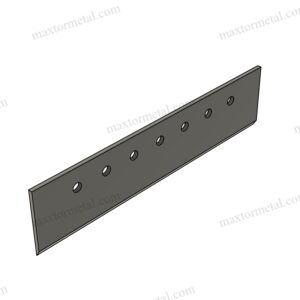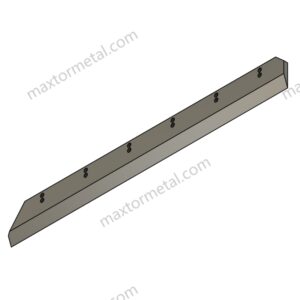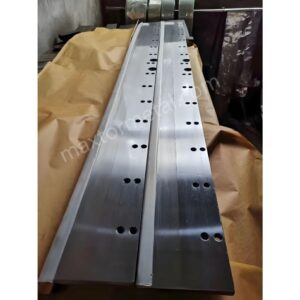| Andere Namen | guillotine blades, guillotine cutters, guillotine knife, industrial blades for paper, paper converting knives, paper cutting blades, paper cutting knife materials, paper slitter blades |
|---|---|
| Herkunftsort | China |
| Anwendung | Kunststoff, Papier, Karton, Vliesstoff, Film, Folie, Etiketten, Klebeband, Textil, Verpackung, Teppich, Taschen, Gummi |
| Material | 65Mn,9CrSi,Cr12MoV,SKD-11,HSSl |
| Modellnummer | CV-RS |
| OEM-Service | Verfügbar |
| Zahlungsbedingungen | L/C, T/T, Western Union |
| Verpackung | Karton, Holzkisten |
| Lieferzeit | 7-20 Tage |
Teilen auf:
Industrial paper cutting knives, also known as paper cutting blades or guillotine blades in some contexts, are robust and precision-engineered cutting tools designed for use in industrial paper cutting machines. These knives are built to efficiently and accurately cut large stacks or continuous webs of paper and paperboard in high-volume production environments. The term “industrial paper cutting knives” emphasizes their heavy-duty construction and suitability for demanding, continuous operation in manufacturing and converting processes within the paper, printing, and packaging industries.
Industrielle Papierschneidemesser are essential tools in various stages of paper processing and converting. Their key applications include:
The selection of material for Industrielle Papierschneidemesser is crucial for achieving optimal cutting performance, longevity, and resistance to wear, especially when dealing with various paper types, including abrasive and coated papers. Common materials include:
Coatings such as titanium nitride (TiN) or chromium can be applied to enhance surface hardness, reduce friction, and improve corrosion resistance, further extending the life of Industrielle Papierschneidemesser.
Industrielle Papierschneidemesser come in various shapes and configurations tailored to specific cutting processes and machinery. Common shapes include:
The geometry of the industrial paper cutting knife, including the blade angle, bevel, and edge sharpness, is critical for achieving clean, accurate cuts and maximizing blade life. The correct selection of blade shape and material depends on the type of paper being cut, the cutting process, and the production volume requirements.






Genießen Sie den Komfort eines nahtlosen Imports. Vom Transport bis zur Zollabwicklung übernehmen wir den gesamten Prozess. Sie müssen lediglich die Mehrwertsteuer entrichten und auf die Ankunft Ihrer Waren warten.
Wir haben unsere Klingen in unzähligen Anwendungen bewiesen und sind bereit für jedes Projekt, das Sie uns vorstellen. Erwarten Sie Genauigkeit, Langlebigkeit und unübertroffen wettbewerbsfähige Preise.
Ob Sie Zeichnungen, Skizzen oder Muster bereitstellen, wir können für Sie entwerfen und fertigen. Wir haben auch die Fähigkeit, bei der Modifizierung bestehender Designs und Spezifikationen zu helfen, um nahezu jede industrielle Werkzeuganwendung zu verbessern. Bitte kontaktieren Sie unser engagiertes Vertriebsteam, um Ihre spezifischen Anforderungen zu besprechen.
Eine Reihe von Tests und Inspektionen werden zur Qualitätskontrolle durchgeführt, darunter die Erstmusterprüfung, die Wareneingangsprüfung und Materialzertifizierung, die In-Prozess-Qualitätsprüfung und die Endqualitätsprüfung.
Ob Sie ein Importeur, Distributor, Großhändler oder Endverbraucher sind, wir heißen Sie herzlich willkommen. Profitieren Sie von minimalen Mindestbestellmengen (MOQs), problemlosen Anfragen und größerer Einkaufsfreiheit.
Betrachten Sie uns als Ihren exklusiven Monitor. Wir werden Ihnen regelmäßig Updates zu jedem wichtigen Knotenpunkt Ihrer Produktionslinie liefern. Egal wie weit entfernt, Sie erhalten Echtzeit-Einblicke in den Fortschritt Ihres Produkts.
Der ultimative Leitfaden zur Wartung von Guillotine-Schneideklingen: Verlängern Sie die Lebensdauer und optimieren Sie die Leistung
Nanjing Metal Industrial CO., Limited
Mingjue Industrial Park, Lishui, Nanjing, Jiangsu, China
Bleiben Sie auf dem Laufenden mit unseren aktuellen Nachrichten.